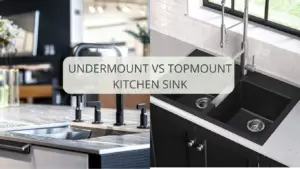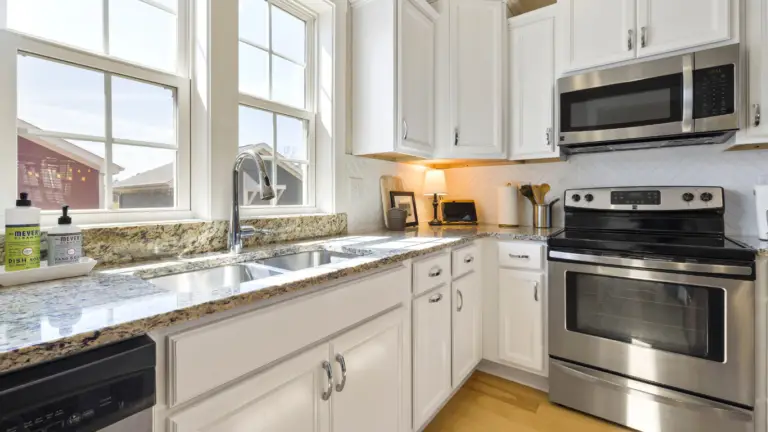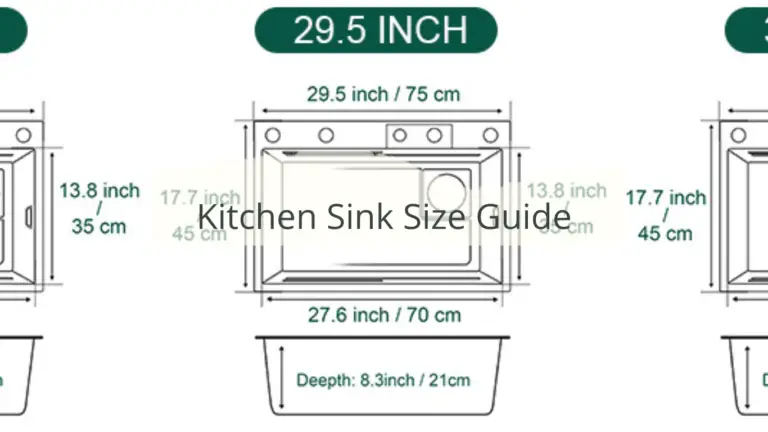Undermount vs. Top Mount Kitchen Sink; Which is Better?
This post may contain affiliate links which means I may receive a commission for purchases made through links.

While there are several types of kitchen sinks, each unit is mounted to the countertop in one of two ways; undermount or top-mount! So, if you’re planning to remodel your kitchen, you have to decide between an under-mount or top-mount sink sooner or later.
As you would expect though, choosing between these kitchen sinks isn’t a walk in the park. After all, choosing the right type of kitchen sink is as important as other crucial aspects of the remodel like backsplash, countertop, flooring, and cabinets. Moreover, the sink is one of the most used elements in the kitchen.
That said, which kitchen sink is better for your home; Undermount or top-mount sink?
In this post, we’ll look at the pros, and cons as well as the notable differences between these sinks. Hopefully, that information will help you find the perfect option for your kitchen and family.
Without further ado, let’s get right into it!
What is an undermount kitchen sink?
As the name suggests, undermount kitchen sinks are installed from underneath the kitchen countertop. In short, unlike a drop-in/ top-mount sink, the edge of an under-mount sink is attached to the underside of the countertop, instead of sitting on top of it. As a result, you will not see any lip between the sink and the counter since the edges of the countertop and sink are level.
In recent years, under mount sinks have become increasingly popular among many homeowners who want to have a sleek, seamless look in their kitchen. Even better, these kitchen sinks are relatively easy to keep clean since they don’t have a lip around the edge of the sink. For that, you can easily wipe debris directly into the kitchen sink, eliminating the need to clean around the sink’s rim.
On the downside, you may need special mounting clips that attach the under-mount sink to the countertop’s underside during installation. In addition, you’ll need a silicone caulk to seal the sink to the countertop to create a watertight seal. All these factors make under-mount sinks more costly to install compared to drop-in sinks due to the precision needed for installation.
Types of under-mount sinks available
Undermount kitchens can be classified into 3 groups;
- Zero reveal. This setup refers to when the under-mount sink is perfectly aligned to the countertop. As a result, there are no revealed edges, making it easier to keep your sink clean. However, zero reveal comes with an added expense as it requires more precision during installation.
- Negative reveal. A negative reveal refers to when the countertop slightly extends beyond the edge of the undermount sink from all sides. Unfortunately, the extended edge is more susceptible to chipping.
- Positive reveal. Finally, a positive reveal is when the countertop reveals some portion of the undermount sink rim. This gives the designer considerable leeway when cutting the sinkhole and provides an easy way to keep the sink clean.
Benefits of under-mount kitchen sink
-
Easier to clean
Undermount is much easier to clean compared to traditional sinks with a rim since there is no obstruction between the sink and the countertop. As a result, you can easily wipe away food crumbs and kitchen spills right into the sink without any obstruction.
One thing you need to note though is that debris can accumulate at the mounting point right below the counter. For that, it’s important to replace the caulk underneath the countertop every 3 years to get rid of the accumulated debris.
-
Seamless look
An under-mount sink appears as if the countertop is flowing right into the sink, giving it a sleek look while maximizing your countertop space. Even better, the under-mount sink will look more integrated with the countertop, providing an even sleeker look.
-
Undermount sinks are usually hand-made
Most Undermount kitchens are usually hand-made with thicker steel, giving them a longer life and extending their durability. In comparison, pressed sinks have much lower quality since they’re crafted from thinner and more fragile steel sheets.
Drawbacks of under-mount kitchen sink
-
Expensive
As mentioned above, under mount sinks are usually handmade, which makes them more costly than pressed sinks. In addition, they’re more costly to install than their top-mount counterparts as they have higher labor costs.
-
Hard to install
In addition to higher labor costs, under-mount sinks are generally harder to install than top-mount sinks. This is because they require additional support for their weight as they don’t have any support above the countertop. Moreover, the cabinet maker has to consider the sink material to ensure the cabinet can support the weight of the sink. On the other hand, your stonemason has to determine the exact dimensions of the sink bow so that they can smoothen the edges of the countertop. All these factors make the installation of under-mount sinks more challenging and costly than other sink options.
-
Not ideal for laminate and wooden countertops
Finally, if you have a wooden or laminate countertop, an under-mount sink may not be the best option for your kitchen. This is because the sink will expose the countertop to water, causing damage to your wooden or laminate countertop over time.
What is a top-mount kitchen sink?
Also known as a drop-in or self-rimming sink, a top-mount sink is installed by resting it into a pre-cut hole in the countertop. More notably, the sink sits on the top of the kitchen countertop, while its lip/ rim holds the sink in place by resting above the countertop. Silicone caulk is then used to seal the gap whether the countertop and rim meet to keep buildup and water away.
One major benefit of top-mount kitchen sinks is that they’re relatively easy to install, making them a popular option for DIY homeowners. In addition, they’re less costly than under-mount sinks and ideal for use on various countertop materials.
However, drop-in sinks are more difficult to clean than their under-mount counterparts since grime and dirt tend to accumulate around the edge of the kitchen sink. Other than that, they’re a practical and budget-friendly option for many homeowners as they’re compatible with various kitchen styles.
Types of top-mount kitchen sinks
There are 2 main types of top-mount kitchen sinks; hand-made and pressed sinks.
As the name implies, pressed kitchen sinks are made using a machine that presses a single steel sheet and forms into the shape of the sink. This results in cheaper and relatively thinner sinks than hand-made sinks.
In comparison, hand-made kitchen sinks are made using laser welding technology and thick, higher-quality materials. The only issue with this manufacturing process is that it increases the cost of the sink, making hand-made top-mount sinks more costly than their pressed counterparts.
Benefits of top-mount kitchen sinks
-
Easy to install
The process of installing a drop-in kitchen sink is both simple and efficient. After all, you only need to cut a hole in the countertop that perfectly fits the sink and then ‘drop it in’. However, you should ensure that the hole is small enough for the lip to sit on the countertop and all edges, but large enough to fit the sink.
-
Comes at affordable prices
Most top-mount sinks are usually made as pressed kitchen sinks. For that, they’re relatively affordable compared to other sink styles, making them a great option for those who want a budget-friendly kitchen sink. However, pressed sinks are not as stylish, and durable and are significantly noisier than handmade sinks.
-
Available in various styles & designs
Top mount sinks are available in various designs and styles, making it easy to find the right option based on your preference. Also, they’re branded under various names such as over-mount, drop-in, and top-mount sinks, which can potentially increase their value.
-
Easier to replace
Unlike under-mount sinks, top-mount sinks are relatively easy to replace if you ever need to change them. This makes it easy to upgrade your kitchen sink from a granite to a stainless steel sink or from a single bowl to a double bowl unit and vice versa.
-
Less gunk and residue build-up
When you keep washing dishes in your sink, gunk and residue start to build up in the hidden places and around the edges of the sink. Interestingly, this is less likely to happen with a top-mount sink since you can easily see all its parts and clean the entire sink.
Drawbacks of top-mount kitchen sinks
-
Top-mount/ Drop-in sinks are usually pressed sinks
Pressed sinks are made from a thin steel sheet that is punched in shape with a hydraulic press. While this makes them cheaper to make, they are not that durable since the steel sheet is usually fragile.
In addition, these kitchen sinks are not as good-looking as under-mount sinks. Plus, they generate a lot of noise, and food chunks can accumulate around the edges over time. For that, it’s important to clean your top-mount sink regularly to prevent bacteria and mold buildup.
Detailed Comparison: Undermount vs. Top-Mount kitchen sink
-
Cost
Drop-in sinks are more budget-friendly than under-mount sinks. Even better, they’re easier and cheaper to install, making them a perfect choice for those looking for an affordable sink.
On the other hand, undermount sinks are generally considered the most expensive. This is because they’re made from thicker, higher-quality materials, making them more durable than most drop-in sinks. In addition, they take longer to set up as they involve a more intensive, time-consuming installation process.
-
Ease of cleaning & maintenance
Since top-mount sinks have a rim on top of the countertop, they gather more food crumbs than under-mount sinks. As a result, they’re a little hectic to clean and maintain.
In comparison, under-mount sinks do not have a rim between the sink and the countertop. For that, they’re easier and quicker to keep clean. However, debris can accumulate just below the countertop whether it meets the sink. To avoid that, make sure you replace the caulk between the sink and the countertop every 3 years.
-
Appearance
Top-mount sinks have a rather traditional, timeless look, which makes them ideal for use in any kitchen style. For instance, if you’ve got a classic-style kitchen, you can complement its overall look with an enamel cast-iron or porcelain drop-in sink.
However, if you want to take things a notch higher in terms of appearance, an under-mount sink is a better choice than a drop-in sink. That is because it has a clean, streamlined, modern look that works well with contemporary kitchen styles.
All in all, both types of sins will increase the curb appeal of your home to a certain extent. After all, the look of the kitchen sink eventually comes down to a matter of personal preference.
-
Countertop space
Undermount sinks give the illusion of a bigger countertop than with a top-mount sink. One reason for this is that under-mount sinks take up less countertop space than their top-mount countertops. So, if your kitchen counter has limited space, an under-mount sink will give you slightly more surface area than a drop-in sink. At the same time, this will allow you to draw more attention to the material of the countertop.
Alternatively, you can consider a drainboard sink to make the most of your countertop space. Specifically, this type of kitchen sink comes fitted with a food preparation area or drainboard that extends up to 10” beyond the side of the kitchen sink basin.
-
Countertop compatibility
As mentioned earlier, undermount sinks are not ideal for use on countertops that are made from laminate, MDF, or particleboard as they’re vulnerable to water damage. So, if you’re planning to install the sink on those countertop materials, you should stick to a top-mount sink instead.
Which is Better: Undermount or Top-Mount kitchen sink?
As you can see, there are various factors you need to consider when comparing under-mount vs. top-mount kitchen sinks. Some of these factors include; cost & ease of installation, countertop material, countertop space, and how often you’ll use the sink.
In general, under-mount sinks are a great option if you want an elegant look in your kitchen. On the other hand, top-mount sinks are less costly to install, making them ideal for outdoor kitchens and homeowners on a budget. All in all, the final decision will ultimately come down to your budget, kitchen design, and personal preference.







order progesterone 200mg without prescription – buy progesterone 100mg online buy fertomid generic